The Intel Optane SSD P5800X expands on Intel’s fastest tier of SSD storage. We’ve seen Optane SSDs roll through the lab a good deal with the P4800X, which was launched a touch over four years ago. Over time Intel bumped the capacity of the drive (which started at 375GB), topping out at 1.5TB. The small capacities were okay though, as Optane SSDs we primarily designed for endurance and frequently used in a two-tier architecture. Here the SSDs could absorb writes, which is typically where NAND SSDs fall down. We saw Optane do well in this role with Azure Stack HCI and VMware vSAN, amongst others. Now we’re hands-on in this review with the latest generation Intel Optane SSD P5800X, to see how the platform has grown.
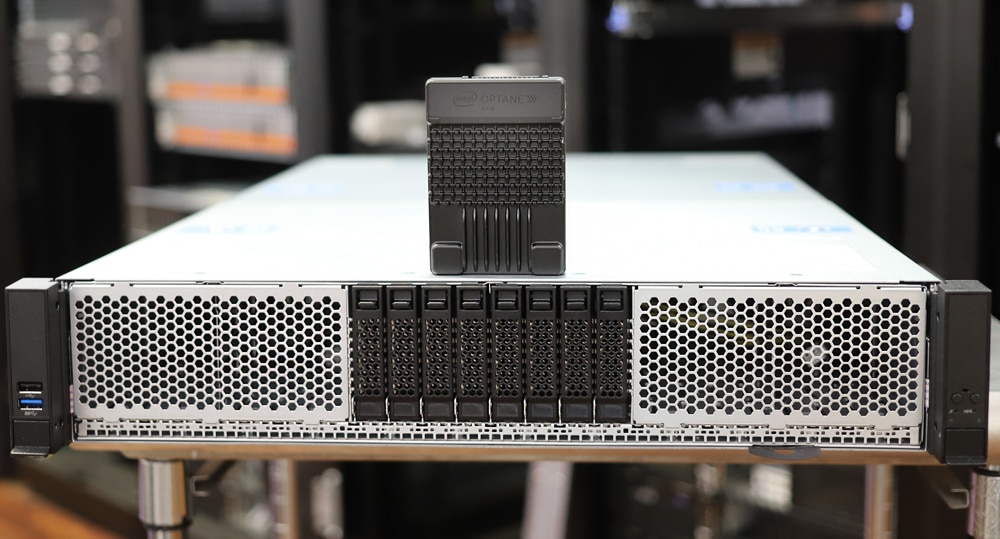
What’s New with the Intel Optane SSD P5800X
Intel isn’t holding back on grandstanding with the Intel Optane SSD P5800X. They’ve dubbed the drive, “The world’s fastest data center SSD.” The numbers from Intel look really great too until you realize they’re comparing to their P5600 NAND-based SSD. Either way though, the P5800X does get a big boost over the P4800X where it matters, endurance with 100 DWPD.
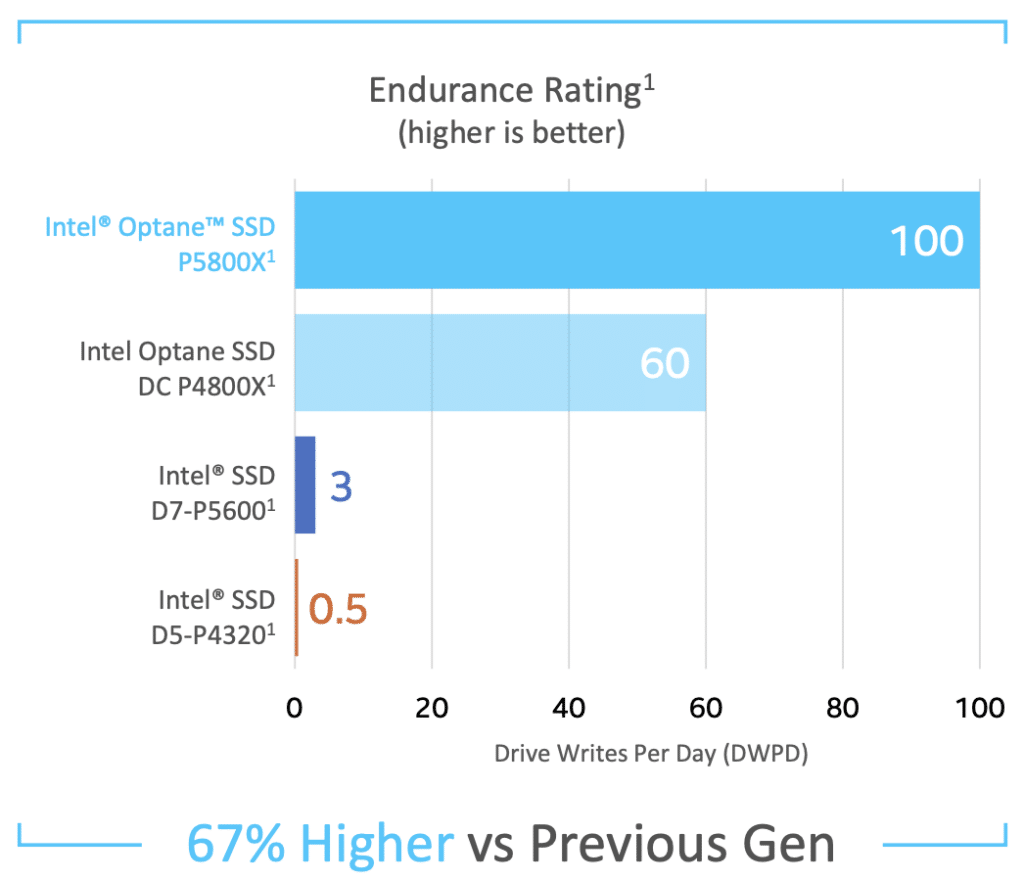
Because the Intel Optane SSD P5800X is used in so many multi-tier storage configurations, the endurance of the drive is critical. Optane SSDs are often set up to absorb all of the writes in a system, protecting larger, slower media behind it. These can be QLC SSDs for instance, that perform well for read-heavy workloads, but don’t have much endurance or write performance. In this way, the P5800X is a perfect companion for slower media. Many software vendors have figured this out. vSAN, Azure HCI, StorONE, and many others are well adept at making multi-tier work well.
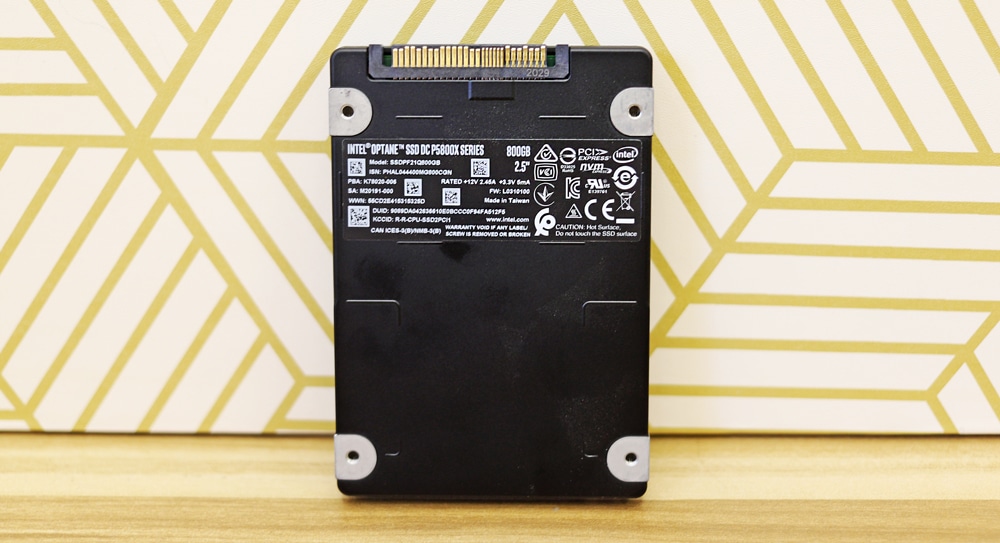
As mentioned during Intel Memory and Storage event, the company is now rolling out its second-generation of Optane products, the class of storage that sits between memory and traditional NAND often referred to as storage-class memory. The P5800X takes advantage of the new media as well as the PCIe Gen4 interface (that can now be leveraged thanks to 3rd gen Intel Xeon Scalable processors) for even higher speeds.
The quoted numbers are quite impressive with top speeds being 7.4GB/s and a throughput of up to 2 million IOPS, all of this with really low latency to boot. The QoS offers predictable performance at very low latency as well. The predictable and low latency make it an attractive choice for financial services (fraud detection, analytics, compliance, and market modeling) as well as real-time bidding (ad requests, bid requests, bidding, and ad delivery).
The Intel Optane SSD P5800X comes with a five-year warranty and in capacities of 400GB, 800GB, and 1.6TB. For our review, we are looking at the 800GB model.
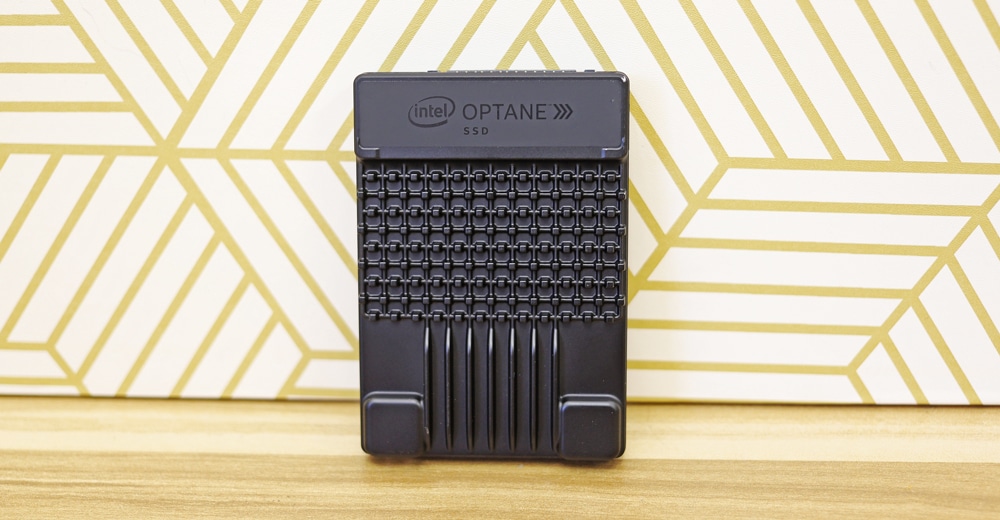
Intel Optane SSD P5800X Specifications
| Capacity | 400GB, 800GB, 1.6TB |
| Form Factor | U.2 and E1.S |
| Media | Second generation Optane |
| Interface | PCIe 4.0 1×4, 2×2, NVMe 1.3d |
| ASIC/CPU | Single-core 1.1GHz ARM Cortex R7 |
| Media Channels | 8-12 |
| Performance | |
| Sequential Read | Up to 7.4GB/s |
| Sequential Write | Up to 7.4GB/s |
| Radom 4K Read | Up to 1.55 million IOPS |
| Random 4K Write | Up to 1.6 million IOPS |
| Random 4K 70/30 | Up to 2 million IOPS |
| QoS (4KRR, QD=1, 99%) | <6µs |
| QoS (4KRR under 2GB/s 4K RW, 99.999%) | <66µs |
| Endurance | 100 DWPD |
| Warranty | 5-year |
Intel Optane SSD P5800X Performance
Testbed
Our new PCIe Gen4 Enterprise SSD reviews leverage a Lenovo ThinkSystem SR635 for application tests and synthetic benchmarks. The ThinkSystem SR635 is a well-equipped single-CPU AMD platform, offering CPU power well in excess of what’s needed to stress high-performance local storage. It is also the only platform in our lab (and one of the few on the market currently) with PCIe Gen4 U.2 bays. Synthetic tests don’t require a lot of CPU resources but still leverage the same Lenovo platform. In both cases, the intent is to showcase local storage in the best light possible that aligns with storage vendor maximum drive specs.
PCIe Gen4 Synthetic and Application Platform (Lenovo ThinkSystem SR635)
- 1 x AMD 7742 (2.25GHz x 64 Cores)
- 8 x 64GB DDR4-3200MHz ECC DRAM (1 x 64GB for Houdini)
- CentOS 7.7 1908
- Ubuntu 20.10-desktop
- ESXi 6.7u3
PCIe Gen3 Synthetic Platform (Dell PowerEdge R740xd)
- 2 x Intel Gold 6130 CPU (2.1GHz x 16 Cores)
- 4 x 16GB DDR4-2666MHz ECC DRAM
- 1x PERC 730 2GB 12Gb/s RAID Card
- Add-in NVMe Adapter
- Ubuntu-16.04.3-desktop-amd64
Testing Background and Comparables
The StorageReview Enterprise Test Lab provides a flexible architecture for conducting benchmarks of enterprise storage devices in an environment comparable to what administrators encounter in real deployments. The Enterprise Test Lab incorporates a variety of servers, networking, power conditioning, and other network infrastructure that allows our staff to establish real-world conditions to accurately gauge performance during our reviews.
We incorporate these details about the lab environment and protocols into reviews so that IT professionals and those responsible for storage acquisition can understand the conditions under which we have achieved the following results. None of our reviews are paid for or overseen by the manufacturer of equipment we are testing. Additional details about the StorageReview Enterprise Test Lab and an overview of its networking capabilities are available on those respective pages.
Houdini by SideFX
The Houdini test is specifically designed to evaluate storage performance as it relates to CGI rendering. The Gen3 testbed for this application is a variant of the core Dell PowerEdge R740xd server type we use in the lab with dual Intel 6130 CPUs and 64GB DRAM. For Gen4 devices we use the Lenovo ThinkSystem SR635 outfitted with a 64-core 7742 CPU and DRAM lowered to 64GB. On out Gen3 platform, we installed Ubuntu Desktop (ubuntu-16.04.3-desktop-amd64) running bare metal, while our newer Gen4 platform uses Ubuntu 20.10-desktop. Output of the benchmark is measured in seconds to complete, with fewer being better.
The Maelstrom demo represents a section of the rendering pipeline that highlights the performance capabilities of storage by demonstrating its ability to effectively use the swap file as a form of extended memory. The test does not write out the result data or process the points in order to isolate the wall-time effect of the latency impact to the underlying storage component. The test itself is composed of five phases, three of which we run as part of the benchmark, which are as follows:
- Loads packed points from disk. This is the time to read from disk. This is single-threaded, which may limit overall throughput.
- Unpacks the points into a single flat array in order to allow them to be processed. If the points do not have a dependency on other points, the working set could be adjusted to stay in-core. This step is multi-threaded.
- (Not Run) Processes the points.
- Repacks them into bucketed blocks suitable for storing back to disk. This step is multi-threaded.
- (Not Run) Writes the bucketed blocks back out to disk.
Here, the P5800X came out on top of the drives tested with only 1,799.5 seconds. This also puts it in the top four results we’ve ever seen.
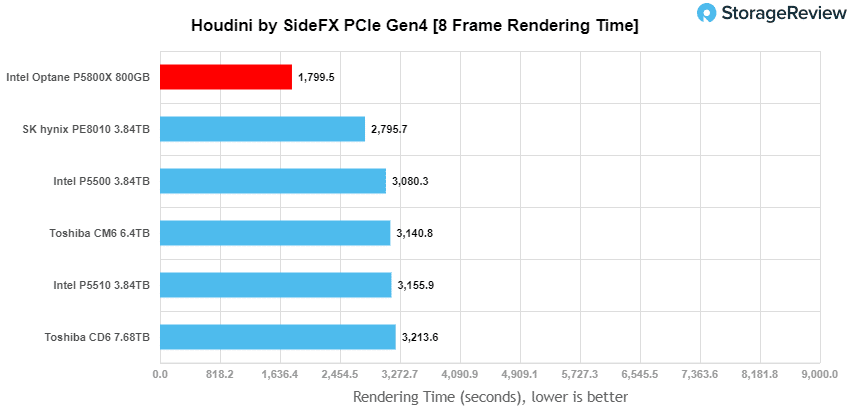
VDBench Workload Analysis
When it comes to benchmarking storage devices, application testing is best, and synthetic testing comes in second place. While not a perfect representation of actual workloads, synthetic tests do help to baseline storage devices with a repeatability factor that makes it easy to do apples-to-apples comparison between competing solutions. These workloads offer a range of different testing profiles ranging from “four corners” tests, common database transfer size tests, to trace captures from different VDI environments. All of these tests leverage the common vdBench workload generator, with a scripting engine to automate and capture results over a large compute testing cluster. This allows us to repeat the same workloads across a wide range of storage devices, including flash arrays and individual storage devices. Our testing process for these benchmarks fills the entire drive surface with data, then partitions a drive section equal to 25% of the drive capacity to simulate how the drive might respond to application workloads. This is different than full entropy tests which use 100% of the drive and takes them into steady state. As a result, these figures will reflect higher-sustained write speeds.
Profiles:
- 4K Random Read: 100% Read, 128 threads, 0-120% iorate
- 4K Random Write: 100% Write, 64 threads, 0-120% iorate
- 64K Sequential Read: 100% Read, 16 threads, 0-120% iorate
- 64K Sequential Write: 100% Write, 8 threads, 0-120% iorate
- Synthetic Database: SQL and Oracle
- VDI Full Clone and Linked Clone Traces
Comparables:
In our first VDBench Workload Analysis, Random 4K Read, the P5800X flat out dusted the other drives and peaked at 1,416,092 IOPS and a latency of just 85.5µs.
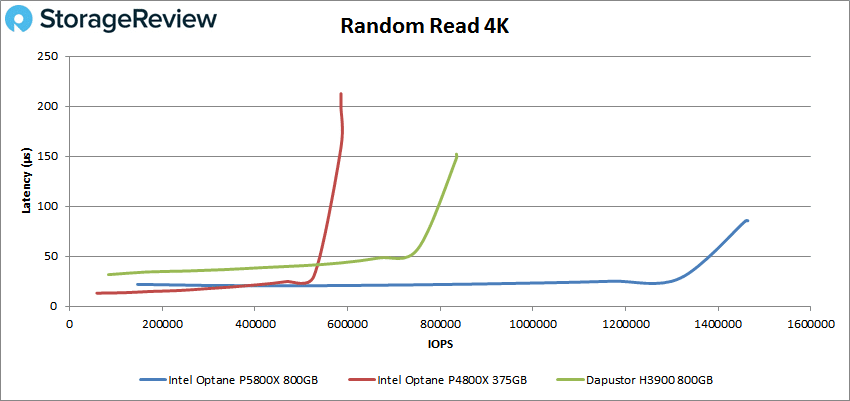
4K random write showed another impressing display of performance and stayed under 100µs throughout with a peak of 1,328,538 IOPS with a latency of just 90.3µs.
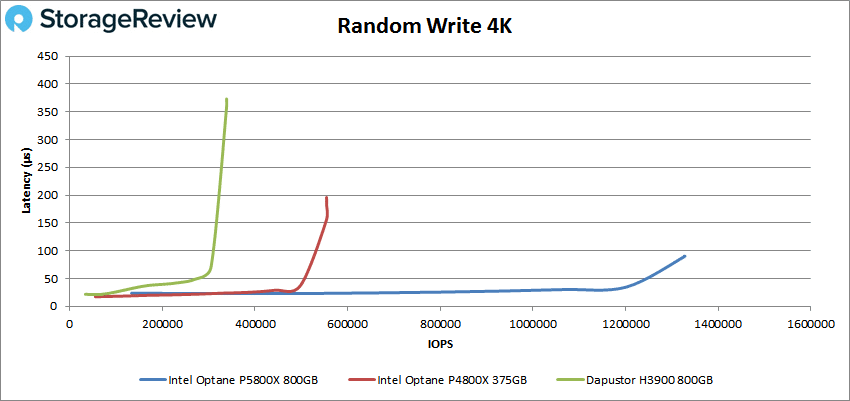
Switching over to sequential workloads, specifically our 64K workloads, in read, there was no real competition. The P5800X hit a peak of 112,979 IOPS or 7.1GB/s at a latency of 281µs.
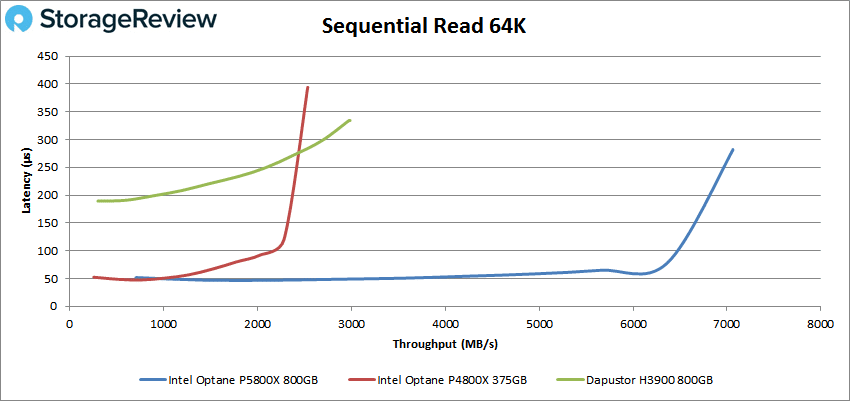
With 64K sequential write the P5800X continued its domination with a peak of 93,579 IOPS or 5.85GB/s with a latency of 161µs.
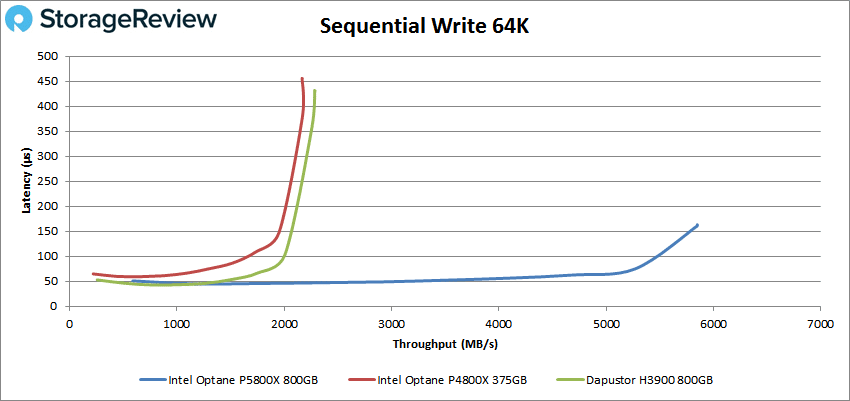
Our next set of tests are our SQL workloads: SQL, SQL 90-10, and SQL 80-20. Starting with SQL, the Intel Optane SSD P5800X kept its impressive pace more than doubling the performance of the next placing drive with a peak of 828,464 IOPS and a latency of 37.6µs.
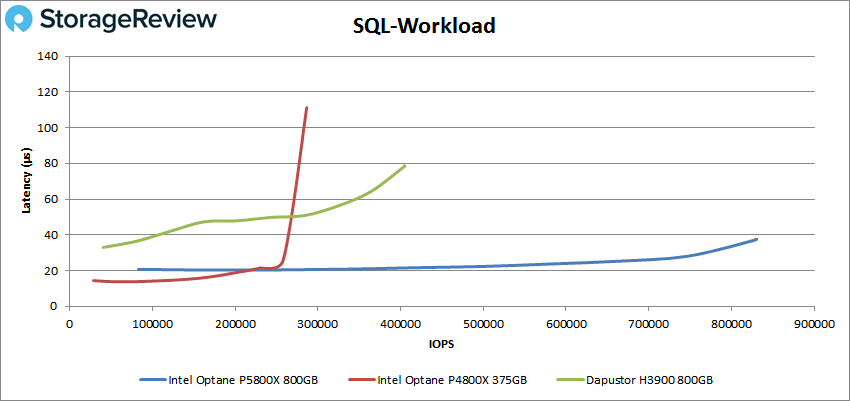
SQL 90-10 had the P5800X hit first with a peak of 808,476 IOPS and a latency of 38.3µs. Again, doubling the performance of the DapuStor with half the latency.
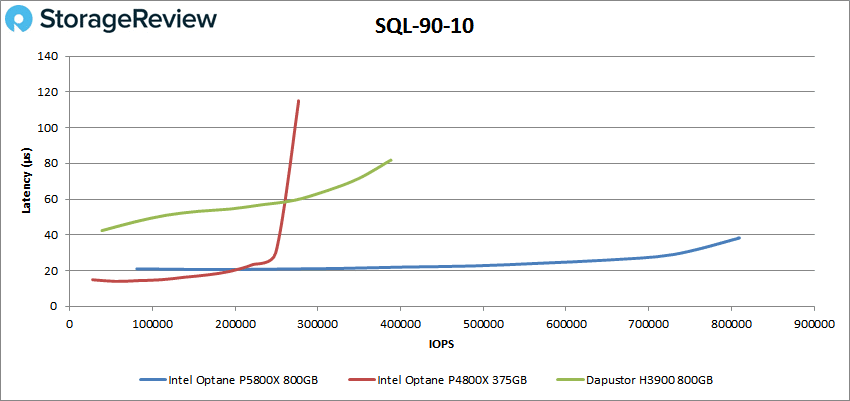
For SQL 80-20 the P5800X once again had really high performance with a peak of 778,015 IOPS at a latency of 39.5µs.
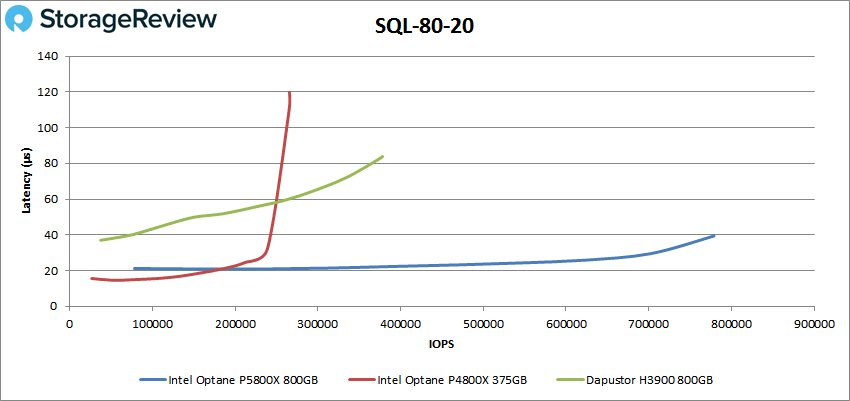
Next up are our Oracle workloads: Oracle, Oracle 90-10, and Oracle 80-20. Starting with Oracle, the Intel Optane SSD P5800X continued to more than double the performance of the next closest drive and come in with very low latencies. In Oracle, the new Optane peaked at 697,772 IOPS with a latency of 48.5µs.
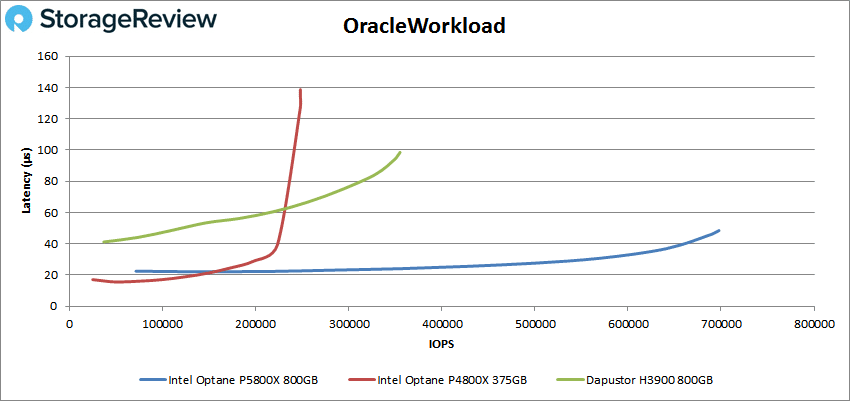
In Oracle 90-10 the P5800X had the top spot with 748,100 IOPS and a latency of just 28µs.
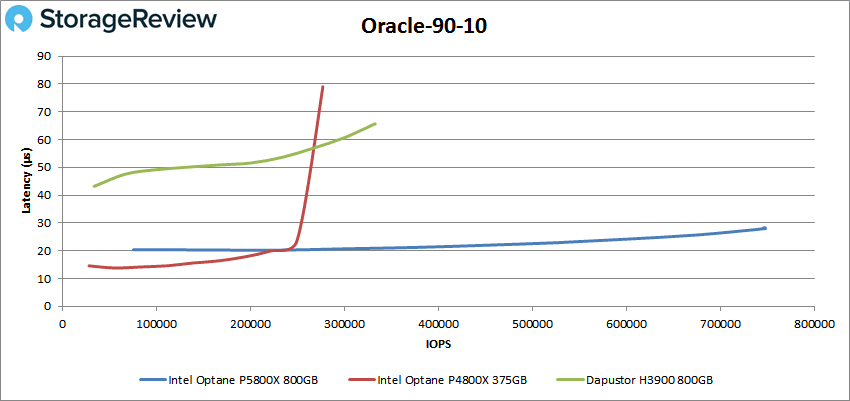
Oracle 80-20 P5800X had an impressive peak of 726,162 IOPS with 28.8µs for latency.
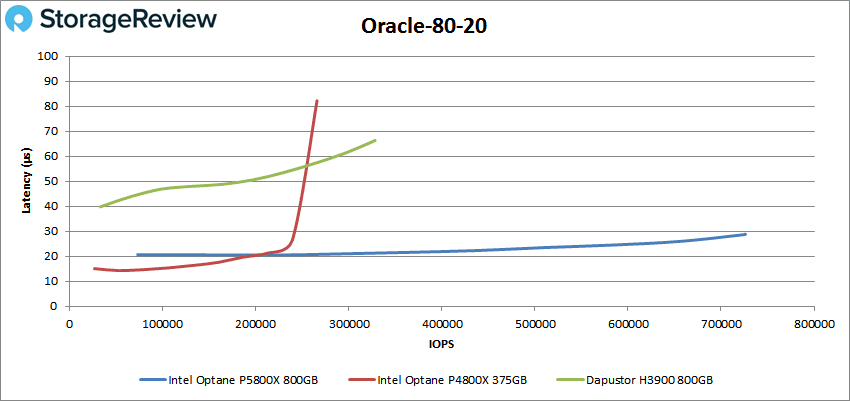
Next, we switched over to our VDI clone test, Full and Linked. For VDI Full Clone (FC) Boot, the P5800X took the top spot easily with a peak performance of 481,166 IOPS and a latency of 70.4µs.
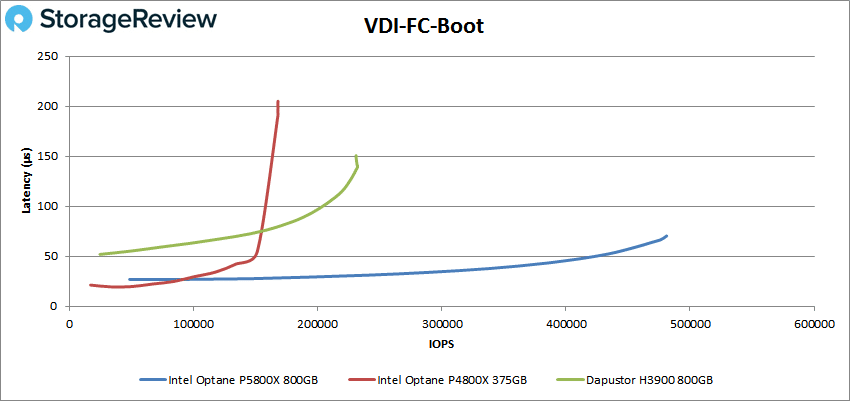
VDI FC Initial Login saw the P5800X hit a peak of 274,042 IOPS and a latency of 105.3µs.
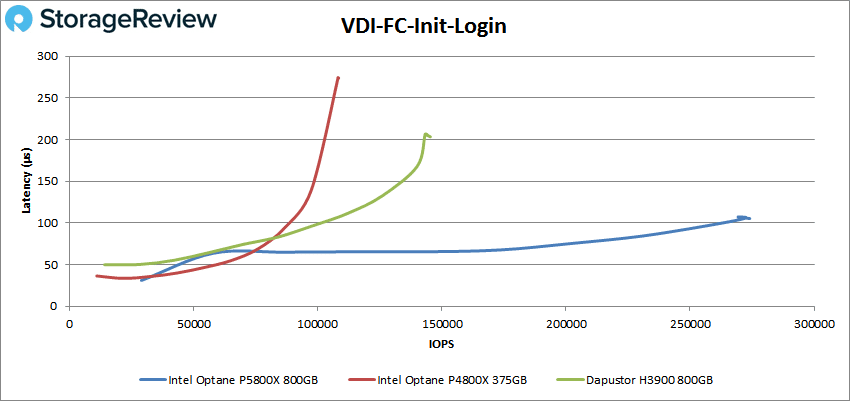
And VDI FC Monday Login once again saw the P5800X way out in the lead with performance of 232,343 IOPS and latency of 65.5µs.
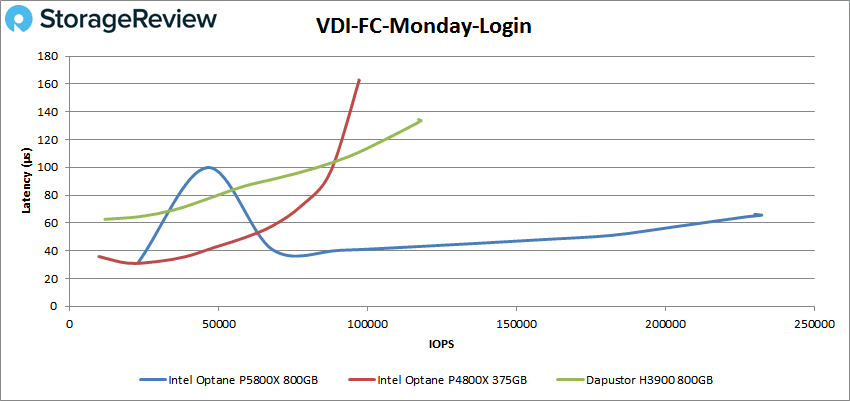
For VDI Linked Clone (LC) Boot, the Intel Optane SSD P5800X had an impressive 247,127 IOPS and 63.6µs for a peak.
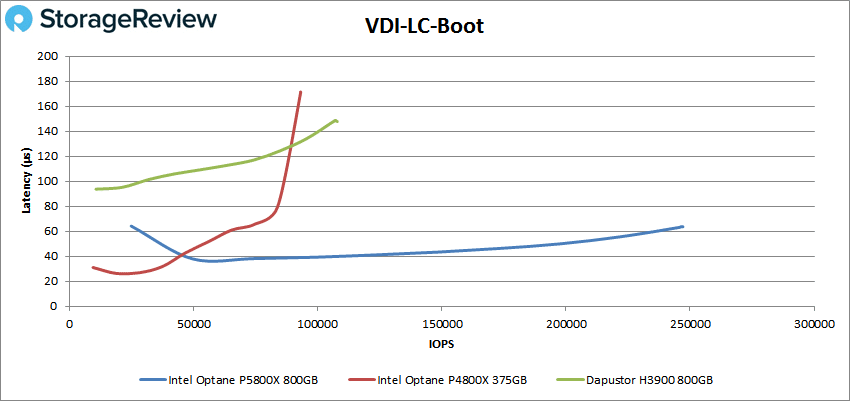
VDI LC Initial Login saw a jump in latency early on but the P5800X still finished strong with 134,846 IOPS and 55.6µs for latency.
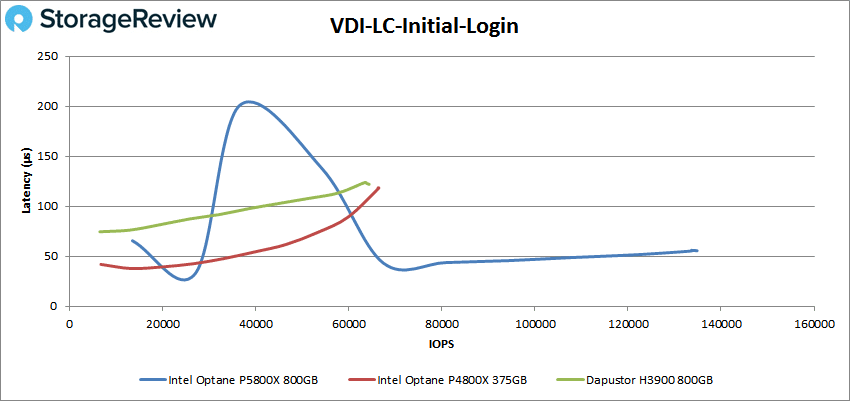
Finally, with VDI LC Monday Login, the P5800X started at a higher latency but quickly dropped down and finished at 168,481 IOPS and 91.1µs for latency.
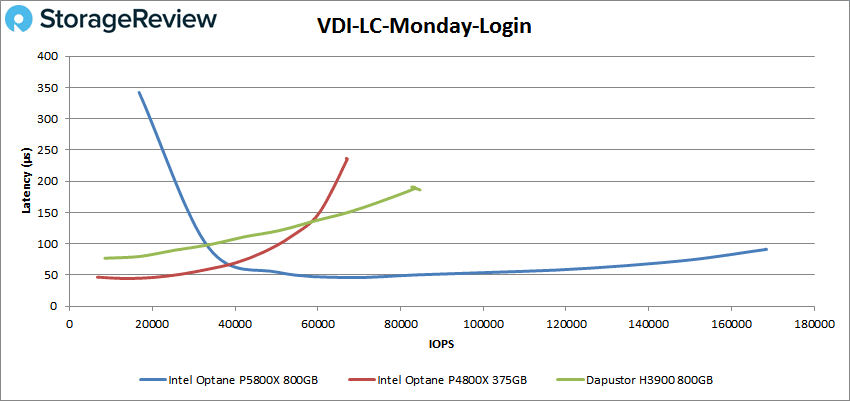
Conclusion
The Intel Optane SSD P5800X is the company’s first enterprise SSD that uses second-generation Optane. And I believe that this is Intel’s first drive to fully leverage PCIe Gen4. The P5800X is a huge step up compared to the P4800X. Right out of the gate it offers higher capacity, up to 1.6TB, something we had to wait for on the first-generation drive. The P5800X has an endurance rating of 100 DWPD and quoted speeds of 7.4GB/s with a throughput of up to 2 million IOPS. The quoted performance combined with ultra-low latency common with Optane makes it ideal for use cases such as FSI and real-time bidding.
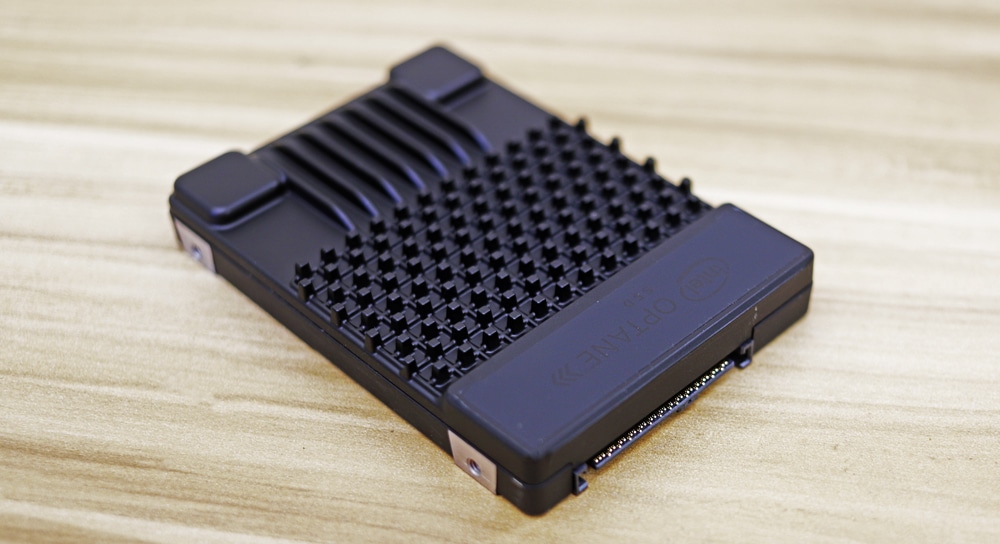
For performance, we ran our Application Workload Analysis and VDBench benchmarks. We compared the P5800X to an Intel P4800X to see how far the technology has come as well as the Dapustor H3900 to compare it to other storage-class memory. It is a comparison of PCIe Gen3 to Gen4 but there are no other Gen4 storage class memory drives in our lab at the moment. In Houdini, the P5800X rendered in 1,799.5 seconds taking the top spot.
With VDBench the P5800X was on top in every test by a large margin. The new Optane kept peak latency under 100µs in just about every test as well. Highlights include 1.4 million IOPS in 4K read, 1.3 million IOPS in 4K write, 7.1GB/s in 64K read, and 5.85GB/s in 64K write.
In SQL server we see a peak of 828K IOPS, 808K IOPS in SQL 90-10, and 778K IOPS in SQL 80-20. In Oracle, we saw peaks of 698K IOPS, 748K IOPS in Oracle 90-10, and 726K IOPS in Oracle 80-20. In our VDI clone tests, we saw Full Clone results of 481K IOPS for Boot, 274K IOPS for Initial Login, and 232K IOPS for Monday Login. With VDI LC we saw 247K IOPS for Boot, 135K IOPS for Initial Login, and 168K IOPS for Monday Login.
The Intel Optane SSD P5800X is the most impressive storage class memory SSD we have yet to see in our testing. Not only did it hit the top of all of our tests it had latency as low as 28µs. With the limited capacity though, the P5800X will still be used in a specialist role for the most part. That is, offering a very responsive tier of storage in systems that are architected to intelligently leverage a variety of storage options. That’s okay though, because when considering the sheer performance of a single drive, the P5800X is widely impressive.




 Amazon
Amazon